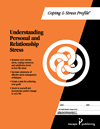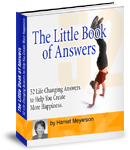Got stress? Have you multi-tasked your way right out of the joy of
being fully present and fully alive? Is it possible to get off of this
merry-go-round of complexity and busy-ness, and by so doing, come away
more successful, healthy, and energized?
The answer is a hearty
Yes! But first let’s face the dilemma.
Traffic jams, technological change, information overload, time-crunch,
relationship struggles, and other stressors can jeopardize our vitality,
our creativity, our productivity, and our joy while costing individuals
and businesses a fortune.
According to a 2001 report
from the American Institute of Stress, U.S. businesses pay 300
billion dollars a year in job-related stress costs.
Unmanaged stress
can influence the onset of heart attacks and strokes, gastro-intestinal
problems, diabetes, insomnia, headaches, and depression, to name
a few. Studies
show that 75% to 90% of all visits to primary care practitioners
are now known to be stress-related.
What is Stress?
When I am doing one of my Three Deep Breaths “Stress-buster” workshops,
I often ask participants to tell me how many of the following scenarios
cause them stress: having
a significant fight with their spouse or boss, taking a vacation
on a south pacific beach, being late for a critical meeting, and
having finally moved into their dream home.
Most of them will say
that only two of those, the fight and being late, cause stress.
But science will state
emphatically that all four could cause stress, because stress occurs
when any significant change – positive
or negative – happens to the mind, body or environment in
which we live.
If we are alive, we will
have stress.
Whether it’s dis-stressful
on our mind, body, or spirit or actually beneficial has a great
deal to do with how we respond.
Stress is one of the best
opportunities to become wiser, stronger, and more flexible. Every
elite athlete knows that he or she must put stress on the body
and mind, training regularly to grow strong and more adaptable.
Managing Stress Is A Balancing Act
The autonomic nervous system is responsible for all those systems
that happen involuntarily within us: our heart rate, our breathing,
our perspiration, the dilation of our pupils, our digestive system,
etc.
There are two complementary
systems in the autonomic nervous system — the
sympathetic and the parasympathetic. The sympathetic can be called
the “Red Alert System,” or the “Fight
or Flight” System.
The parasympathetic, which does the opposite, is the “Green
System,” or
the “Rest and Digest” system. When one is turning on,
the other is turning off.
When a zebra is chased
by a lion, the red alert system is turned on, with everything in
the system delegated to the chase: explosive muscles, increased
heart rate, pain-killing chemicals, hyper alertness — all
to elude the lion and avoid death.
(Read Stanford researcher/author
Robert Sapolsky’s Why Zebras Don’t Get Ulcers for
all the details. It’s one of the few scientific books on stress
that reads like a great historical novel.)
But when you are sitting
in rush-hour traffic already ten minutes late for a critical appointment,
your mind also delivers the thoughts, “I’ve
got to get going, or I’m finished!” And
guess what? Your
autonomic nervous system has not evolved enough to make a distinction
between death by a lion and death by your imaginary thoughts.
So, your
Red Alert lever is also switched on, pumping hundreds of chemicals
and hormones into your system so that you can fight or flee. But
it’s
inappropriate to leap out of the car and bite the fender of the lady
in the SUV in front of you or sprint down the freeway screaming (although
I’m sure these behaviors have been tried by some!). So, you
just sit there with the heartbeat rising, and the perspiration flowing.
Let’s say you eventually make it to the critical appointment
and the client himself is late. Ah, now you can relax and let the “Rest
and Digest” part of the autonomic nervous system clean up the
mess in your body, right? But the phone rings and another client informs
you that they are going with your competitor. Red Alert! Then a memo
arrives hinting at a company-wide layoff. Red Alert! You finally get
to go home at the end of the day to relax but you find bills in the
mailbox, your kid’s flunking algebra, and your spouse has a
headache. Red Alert, Red Alert, Red Alert!!
Are you getting the picture
here? You are on Red Alert 24/7.
There is an imbalance
between the Red Alert/Green Alert systems in the autonomic nervous
system. The stress response/recovery ratio is off kilter and causing
suffering to the body, mind and spirit.
What
To Do?
In the past 30 years, there have been well over 2000 peer-review studies
of mind/body medicine, as well as writings by leading researchers in
the field, such as Herbert Benson, Greg Jacobs and Ellen Langer of
Harvard; Robert Sapolsky of Stanford; Richard Davidson of the University
of Wisconsin; and Paul J Rosch of New York Medical College to name
a few.
They show us that mind/body techniques, which focus on proper
breathing, deep relaxation, and mindfully choosing our perspectives,
can actually bring balance to our autonomic nervous system.
They
teach us that mind/body exercises can be far more valuable
than any symptom-treating pill for modern-day stress.
Since the autonomic nervous system is involuntary, how can we interact
with it directly and effect its workings?
Most people have not been
trained to lower their pulse rate or blood pressure or change their
body temperature at will. And yet everybody can immediately impact
their involuntary nervous system through breath work.
Breathing is
the one direct interface between our voluntary and involuntary
systems. It is the one activity that can happen without our conscious
effort and yet we can also choose to control it consciously, right
now.
You can use a simple practice, the Three
Deep Breaths, to balance
yourself anywhere, any time. Right in the moment, even in the heat
of anger or upset, the first breath can calm and soothe your body,
the second breath can restore the tranquility of your mind, and the
third breath can reunite you with the spirit.
The Three Deep Breaths Practice
The Centering Breath
- Exhale completely to relax the body and empty the lungs of air.
It will support you to place your hands on your abdomen, to be aware
that the breathing includes the belly or center of the body.
- Inhale, noticing that, after a complete exhalation, how deeply
and naturally, the inhalation follows.
- As you continue to inhale and exhale, whether you are sitting
or standing, let your body become more symmetrical and aligned,
feet flat on the ground, and upper body erect, as if someone is
suspending you from a string through the top of your head.
- Visualize
gravity flowing through you, the weight settling underneath of
your feet, leaving you weightless, yet grounded.
- Simply focus on the breath and notice its involuntary nature, how
it happens effortlessly without your conscious energy or intellect.
Inhale naturally through your nose. Exhalation can happen through
nose or mouth. Notice how the inhalation expands the belly out and
the exhalation recedes it in toward the spine.
- Give this breathing
your full attention. No need to do anything – just
watch the breath. You will notice that your breath will tend
to get slower, deeper, quieter, and more regular.
- Allow your attention
to become present in the moment. You will have a sense of “witnessing
the internal and external sensations and thoughts without getting
plugged into them. Your choices and thoughts will become more
purposeful and creative.
The Possibility Breath
As you continue with the
Centering Breath, simply access (breathe in) the “best me I can be.” Another way to think of it
is to breathe in “my highest purpose.” This may change
from situation to situation.
On the way to work it
could be, “I’m
a real team player, giving my job 100% focus and energy.”
Or,
when you’re entering your home at the end of the day,“I
am a loving, joyful, nurturing parent” or “I am
a compassionate and considerate spouse.”
The important point is to breathe
the possibility in with deep diaphragmatic breaths, imagining it
penetrating every cell in your being.
The Discovery Breath
Breathe in the question, “Are my next words or actions going
to come from an intent to defend or from an intent to learn?” Is
this going to be a fight to be right or a wondrous adventure of discovery?
Breathe in the Mystery, the magic of life, and let go of judgments.
Research shows that the keys to managing stress are to be able to
control your response to life events, to treat stressors as challenges,
and to have a sense of commitment to something larger than your ego
(i.e. family, service, life philosophy, faith, etc.)
The Three
Deep Breaths do exactly that. The Centering Breath gives
you control over your response. The Possibility Breath gives you
a higher purpose than your ego. And, the Discovery Breath turns
a stressful situation into a learning opportunity.
When To Do The Three Deep Breaths
Anytime you remember, you can do this simple powerful practice! It
can be done anywhere:
- When you fasten your seat belt
- Sitting in rush hour traffic
- Waiting in line
- Waiting for an appointment
- Before a meeting
- Before entering your home
- When the phone rings
- When you boot up your computer
The Three Deep Breaths
opportunities are endless! But it is the doing of it, in the practice,
that counts! And the good news
is that it doesn’t take time, it takes “intention.” In
addition, the practice is simple, joyful, and energizing.
With
this practice you are balancing the autonomic nervous system. And,
simply by deep diaphragmatic breathing, you will give yourself up
to seven times more oxygen than shallow chest breathing, providing
great vitality to the entire system. And since your brain uses at
least 20% of the oxygen you breathe, increased clarity and focus
and creativity will be yours. Why wait? Do it now!
Thomas Crum is a seminar leader, peak performance coach and best-selling
author of Magic of Conflict and Journey to
Center.
His new book, Three Deep Breaths (Berrett-Koehler
Publishers, Inc) teaches us how to get off the madness of the information-overloaded,
technology-exploded, and relationship-eroded world and emerge with
our true authentic self, prosperous and revitalized. This is precisely
the journey that Angus, the harried Everyman, embarks on in Thomas
Crum’s parable, Three Deep Breaths. The modern,
stressful life of Angus opens up to a field of limitless potential.
With forward written by mega best-selling author, Mark Victor Hansen
(Chicken Soup for the Soul series), Three
Deep Breaths, is an easily digestible parable that provides
the reader with the means to transform work and life. It is a precious
gift for those looking to turn the rat race into a wondrous adventure.
For more information on Tom, his programs and products, visit his
website, www.thomascrum.com, or call 585-924-7302.


 Reveals
the 50 confidence building strategies used by top performing people.
Reveals
the 50 confidence building strategies used by top performing people.
